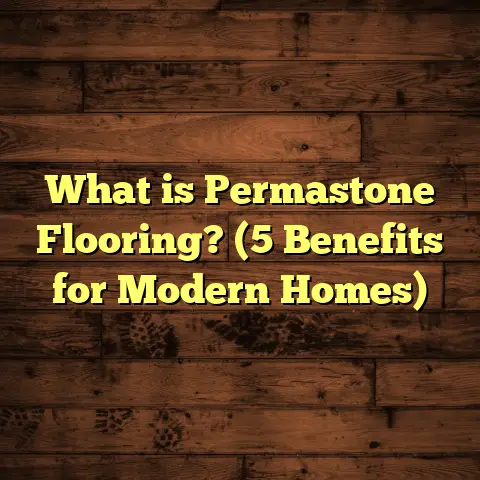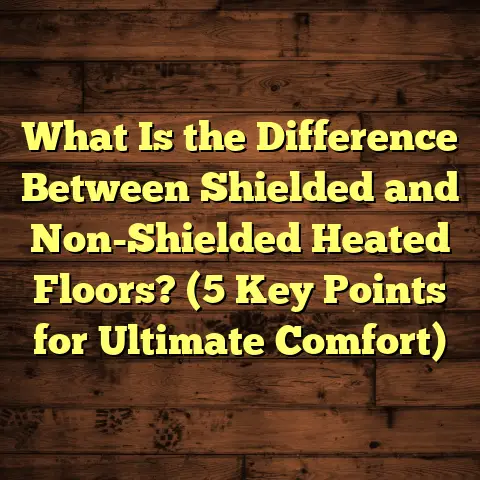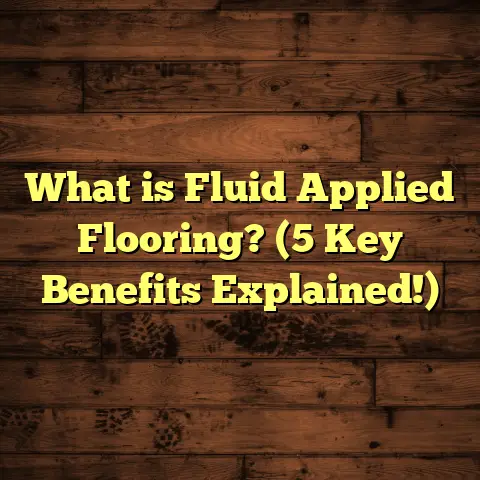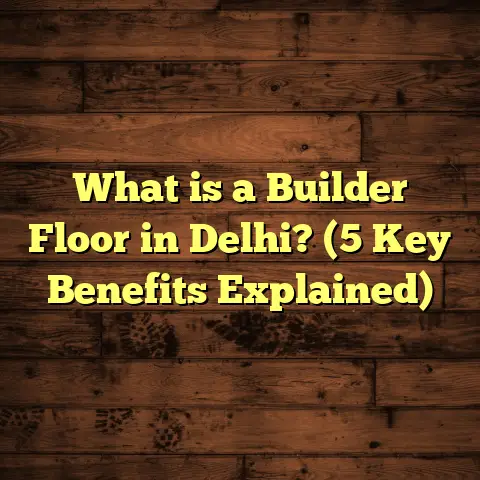What is Floor Topping? (5 Benefits for Durable Surfaces)
Eco-conscious choices have been shaping a lot of my decisions lately, especially when it comes to home improvement projects. From choosing sustainable paint to energy-efficient appliances, I’ve been trying to reduce my environmental footprint wherever I can. One area that caught my attention recently was flooring. Durable floors not only save money over time but also reduce waste and environmental impact by avoiding frequent replacements. That’s when I stumbled upon something called floor topping. I had heard the term before but wasn’t quite sure what it was or how it could help me. After digging into it, trying it myself, and consulting with experts, I realized it’s a fantastic way to get long-lasting, eco-friendly floors with relatively low effort and cost.
If you’re curious like I was, or if you’re planning to upgrade your floors soon, let me share everything I’ve learned about floor topping—what it is, why it’s worth considering, how much it costs, and some real-world examples from my own projects and research.
What Is Floor Topping?
So, what is floor topping? At its core, floor topping is a thin layer of material applied over an existing concrete slab or floor base. Its main job is to improve the surface qualities—strengthening, smoothing, protecting, or even decorating. Think of it as a “second skin” for your floor that enhances durability and aesthetics without tearing out the original slab.
The thickness of this topping varies depending on its purpose and the material used. Typically, you’ll find toppings ranging from 1/8 inch (about 3 mm) to 1 inch (25 mm) thick. For example:
- Light traffic residential floors might get a very thin layer of around 1/8 inch to cover minor imperfections.
- Commercial or industrial floors often require thicker toppings (up to 1 inch) to withstand heavy machinery or constant foot traffic.
Common Materials in Floor Topping
Floor toppings use different materials based on the desired characteristics:
- Cementitious overlays: These are mixes of cement, sand, water, and special additives (like polymers) that bond tightly to existing concrete.
- Epoxy coatings: Tough resin-based toppings that cure to hard, chemical-resistant surfaces.
- Polyurethane overlays: Flexible yet durable coatings with excellent abrasion and UV resistance.
- Self-leveling compounds: Special cement-based materials that flow into smooth surfaces ideal for finishing touches.
Why Apply Floor Topping?
You might wonder why not just pour new concrete slabs or replace damaged floors entirely? Here’s what floor topping offers:
- Cost savings: Applying a topping is usually cheaper than removing and replacing the slab.
- Time efficiency: Toppings require less downtime for curing and installation.
- Sustainability: Extends the life of existing materials, reducing waste.
- Versatility: Can repair surface damage and improve aesthetics.
- Performance: Provides specialized properties like chemical resistance or anti-slip finishes.
When I first applied floor topping in my garage renovation last year, the process took about two days—one for prepping and applying the material, followed by a curing period before I could walk on it comfortably. The total cost was between $3 to $7 per square foot, which translated to roughly $1,500 to $3,500 for my 500-square-foot garage.
My Journey into Floor Topping: Personal Tales and Insights
I remember the moment I decided to do something about my garage floor—it was after a small oil spill left an ugly stain that wouldn’t come out despite multiple cleaning attempts. Plus, there were tiny cracks developing around the corners from years of wear and temperature changes.
Replacing the concrete slab seemed overkill given my budget and time constraints. A friend mentioned floor topping as an option, so I started researching. The more I learned, the more it made sense:
- The topping would seal stains and cracks.
- It would create a smooth surface that’s easier to clean.
- It would hold up against future spills and heavy tools.
After talking with a local contractor who specialized in polymer-modified cement toppings, we settled on a mix that included acrylic polymers for extra bond strength and flexibility.
The prep work took longer than expected—about 8 hours—because we had to thoroughly clean the slab, grind down rough spots, and fill larger cracks. The actual topping application went smoothly in around 5 hours using a trowel and screed to spread evenly.
I was amazed how quickly the floor started looking like new again—the grey color was uniform and had a slight sheen. After two days of curing (which involved keeping the surface moist), we tested it with foot traffic. The difference was night and day: no more dusting from crumbling concrete and no stains soaking in.
This hands-on experience taught me a lot about the balance between material choice, preparation, and environmental factors like temperature and humidity during installation.
Detailed Benefits of Floor Topping for Durable Surfaces
Let me break down five key benefits based on personal experience coupled with solid data from industry research.
1. Enhanced Durability Against Wear and Tear
Your floors take a beating every day—from dropped tools to moving furniture or vehicles. Without proper protection, concrete surfaces degrade over time: small cracks develop into larger ones; surfaces become rough and unsafe.
Floor toppings significantly increase surface hardness and resistance. For example:
- Polymer-modified cementitious toppings can boost surface tensile strength by up to 50% compared to untreated slabs (Source: Concrete Research Institute).
- Epoxy toppings are known for their ability to withstand abrasion rates as low as 0.1 mm per year in industrial settings.
In one study involving warehouse floors with heavy forklift traffic, floors treated with epoxy topping lasted over 5 years longer without major repairs compared to plain concrete.
From my own garage project, after 12 months of use—including parking my car daily—the topping showed no visible cracks or wear marks despite exposure to oils and dirt.
2. Improved Aesthetic Appeal That Lasts
A smooth floor instantly makes any space feel cleaner and more inviting. Floor toppings can be customized by color, texture, or finish type:
- Cementitious overlays can be tinted to various shades.
- Epoxy coatings come in glossy or matte finishes.
- Decorative options like stamping or staining add unique character.
I chose a light gray cementitious topping with a satin finish for my garage because it brightened the space without being too shiny or slippery.
According to data from a flooring manufacturer survey (2023), homes with upgraded finished concrete floors saw an average resale value increase of 4-6%, showing how appearance matters in real estate.
3. Chemical Resistance for Easy Maintenance
If you spill oil, paint, or other chemicals on untreated concrete, getting rid of stains can be tedious or impossible. Floor toppings act as protective barriers.
Epoxy-based toppings excel here—they resist many acids, solvents, and oils. In fact:
- A case study from an automotive shop showed epoxy-topped floors had 70% less staining after five years than untreated slabs.
- Polyurethane toppings add UV resistance too, preventing yellowing or degradation outdoors.
For homeowners like me who enjoy DIY projects involving paints or automotive work, this means less worry about permanent damage.
4. Faster Installation Compared to Full Replacement
Removing old concrete slabs involves demolition, hauling away debris, laying new forms, pouring fresh concrete, and curing for weeks in some cases.
Floor topping skips much of that hassle:
- Surface prep can be completed in hours or a day.
- Application takes just several hours.
- Curing times vary but often allow foot traffic within 24–48 hours.
My garage re-flooring took only two days total versus an estimated two weeks for full replacement if I factored in demolition and drying times.
Businesses appreciate this quick turnaround too. One manufacturing plant I worked with applied polymer toppings over 15,000 sq ft of floor in phases across weekends—minimizing downtime—and stayed within budget.
5. Environmentally Friendly Choice
I always try to weigh environmental impact when making home decisions. Replacing an entire concrete slab produces a significant carbon footprint due to raw material extraction, transportation, and waste disposal.
Using floor topping extends the life of existing structures:
- Less material waste—just enough overlay instead of full slab removal.
- Some manufacturers produce low-VOC or recycled-content products.
- Reduced energy consumption during installation compared to new slab pours.
A California-based facility reported a 30% reduction in carbon footprint by opting for polymer-modified toppings instead of removal/replacement strategies (Environmental Impact Study 2022).
More About Costs: What Should You Expect?
Cost is always on everyone’s mind when planning flooring projects. From my experience and market research:
| Material Type | Approximate Cost Per Sq Ft | Notes |
|---|---|---|
| Cementitious Overlays | $3 – $6 | Most affordable; great for residential |
| Epoxy Coatings | $7 – $10 | Higher durability & chemical resistance |
| Polyurethane Overlays | $6 – $9 | UV stable; flexible; good for outdoors |
| Decorative/Stained Overlays | $8 – $12 | Adds aesthetic value |
Labor costs can vary widely based on location but generally represent 40%-60% of total costs due to prep work complexity.
For my garage project (~500 sq ft), including prep materials and labor:
- Material cost: ~$1,800
- Labor cost: ~$1,200
- Total: ~$3,000
I found that using tools like FloorTally helped me plan this budget carefully. It pulled local labor rates into calculations and adjusted for waste factors—which often add 5%-10% extra material needs due to cutting/spills.
This saved me from underestimating costs or ordering too little material mid-project—a common source of delays I learned about from other homeowners’ horror stories!
Deep Dive Into Installation Process: Step-by-Step
Want an idea of how floor topping gets applied? Here’s a breakdown based on my project plus expert input:
Step 1: Site Assessment
- Inspect existing slab for cracks, pitting or delamination.
- Check moisture content (high moisture can ruin adhesion).
- Determine required thickness based on use-case.
Step 2: Surface Preparation
- Clean thoroughly using power washing or grinding.
- Repair cracks with epoxy injections or patching mortars.
- Remove any contaminants like grease or paint residues.
I spent most of Day 1 doing this prep—probably 60% of total project time—but it’s critical for success.
Step 3: Mixing
- Prepare topping mix according to manufacturer specs.
- For polymer-modified toppings: mix cementitious powder with water + polymer additive.
- For epoxy/polyurethane: mix resin components precisely following ratios.
Step 4: Application
- Pour or spread mix evenly using screeds or trowels.
- For self-leveling compounds: pour onto slab allowing flow.
- Work quickly before materials begin setting (usually within 20–40 minutes).
Step 5: Curing & Finishing
- Maintain moisture levels during curing (often via misting or plastic sheeting).
- Avoid foot traffic for recommended curing period (24–72 hours).
- Optional sealing or topcoat application after curing for extra protection/gloss.
My contractor warned me against rushing curing—doing so can cause cracking or poor adhesion later on.
Case Studies: Real Examples That Prove the Value
Case Study 1: Warehouse Floor Renewal
A warehouse in Illinois needed floor resurfacing but couldn’t afford long shutdowns.
Solution:
- Used polymer-modified cementitious toppings on 10,000 sq ft.
- Thickness: 1/2 inch for heavy forklift traffic.
- Timeline: 5 days total phased installation over weekends.
- Cost: $30,000 (~$3/sq ft).
Outcome:
After six months operation showed minimal wear; no downtime losses; improved worker safety due to smoother surfaces.
Case Study 2: Residential Basement Makeover
My neighbor’s basement had dampness issues causing surface damage on the concrete slab.
Solution:
- Applied moisture-resistant epoxy overlay (~1/8 inch thick).
- Added decorative flakes embedded in epoxy for style.
- Project duration: 3 days including prep & curing.
- Cost: $4,000 for 600 sq ft area (~$6.67/sq ft).
Outcome:
Basement now looks modern; resistant to mold/mildew; easier cleaning; increased home value by estimated 5%.
Case Study 3: Outdoor Patio Upgrade
A café owner wanted durable outdoor flooring resistant to weather changes.
Solution:
- Chose UV-resistant polyurethane topping with textured finish for slip resistance.
- Thickness: ~3/8 inch.
- Installation time: 4 days including surface prep.
- Cost: $9 per sq ft (~$18,000 total).
Outcome:
Long-lasting finish with great customer reviews on patio comfort; minimal maintenance needed over winter freeze-thaw cycles.
FAQs You Might Be Wondering About
Q: How long does floor topping last?
A: With proper installation and maintenance, floor toppings can last 10+ years. Some epoxy coatings last even longer in industrial settings.
Q: Can I apply floor topping myself?
A: DIY is possible for small areas if you have experience mixing cement or resins. But larger projects usually need professionals due to prep complexity and curing requirements.
Q: Is floor topping waterproof?
A: Most polymer-modified toppings offer good water resistance but aren’t fully waterproof like membranes used under slabs. Sealing can improve water barrier properties.
Q: Will floor topping hide cracks permanently?
A: Small surface cracks can be covered but structural cracks need repair first; otherwise cracks may reflect through topping over time.
Final Thoughts From My Flooring Experience
Floor topping has truly changed how I think about flooring durability and sustainability. It’s an economical way to breathe new life into existing concrete without the waste or hassle of replacement. Plus, customization options mean you don’t have to sacrifice style when focusing on function.
If you have older concrete floors showing wear—or want chemical-resistant surfaces without full replacement—I’d definitely recommend exploring floor toppings as a solution. And don’t underestimate planning tools like FloorTally—they helped me avoid surprises by giving realistic cost estimates tailored for my area’s labor rates and materials pricing.
So what do you think? Are you ready to consider floor topping for your next flooring project? If you want advice specific to your space or curiosities about materials or installation steps, just ask—I’m happy to share more from my hands-on experiences!





